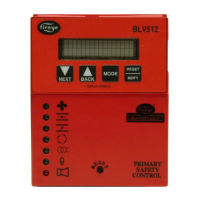© 2023 Carrier 2
Wiring bases for the BurnerLogix control are available for easy installation or with an integral
terminal block capable of a accepting up to 2 X 14 AWG wires. The wiring base terminal block
is available with knockouts for conduit or open ended for cabinet mounting.
Additional functions of the BurnerLogix system include:
• A non-volatile memory allows the control to remember its history and present position even
when power is interrupted.
• A consistent flame signal read-out via display module or 4-20 mA output.
• Read-out of main fuel operational hours and complete cycles via display module.
• Modbus communications via RS485 multi-drop link.
• Proof of fuel valve closure during the off cycle.
• Burn-in time of program parameters occurs after 8 hours of main valve on time.
• A run/check switch allows the operator to stop the program sequence in any of four different
positions (Purge, PTFI, MTFI or Auto).
• Remote Display mounting with NEMA 4 protection.
• Remote Reset.
• Programmable communication baud rate allows for DCS compatibility.
• Keypad selectable language readout.
• Revert to pilot can increase burner turn down.
• Additional terminals provided for applications requiring additional inputs and outputs.
• Fuel Selection switch.
• Intelligent valve proving feature for two-valve systems only.
• Low Gas Pressure Check feature.
• Burner On/Off through Keypad.
CAUTION: While programmers are mechanically interchangeable in that they mate
with a common chassis/amplifier module, you must select the correct model for your
application. Inappropriate application of a control can result in an unsafe condition
hazardous to life and property. Selection of a control for a particular application must
be made by a competent professional, such as a boiler/burner service technician
licensed by a state or other government agency.
NOTICE: This equipment generates and can radiate radio frequency energy, and if
not installed and used in accordance with the instruction manual may cause
interference to radio communications. It has been tested and found to comply with the
limits for a Class A computing device pursuant to Subpart J of part 15 of FCC Rules,
which are designed to provide reasonable protection against such interference when
operated in a commercial environment. Operation of this equipment in a residential
area may cause interference in which case the user, at his own expense, will be required
to take whatever measures which may be required to correct the interference.

